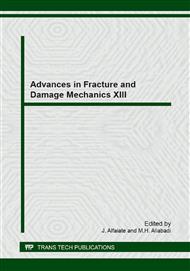p.105
p.109
p.113
p.117
p.121
p.125
p.129
p.133
p.137
Topology Optimization of Geometrically Non-Linear Structures Using Iso-XFEM Method
Abstract:
Iso-XFEM is an evolutionary-based topology optimization method which couples the extended finite element method (X-FEM) with an isoline/isosurface optimization approach, enabling a smooth and accurate representation of the design boundary in a fixed-grid finite element mesh. This paper investigates the application of the Iso-XFEM method to the topology optimization of structures which experience large deformation. The total Lagrangian formulation of the finite element method is employed to model the geometrically non-linear behaviour and equilibrium is found by implementing the Newton-Raphson method in each evolution. A cantilever beam is considered as a test case and the Iso-XFEM solutions obtained from linear and non-linear designs are compared with bi-directional evolutionary structural optimization (BESO) solutions.
Info:
Periodical:
Pages:
121-124
Citation:
Online since:
September 2014
Authors:
Keywords:
Price:
Сopyright:
© 2015 Trans Tech Publications Ltd. All Rights Reserved
Share:
Citation:


